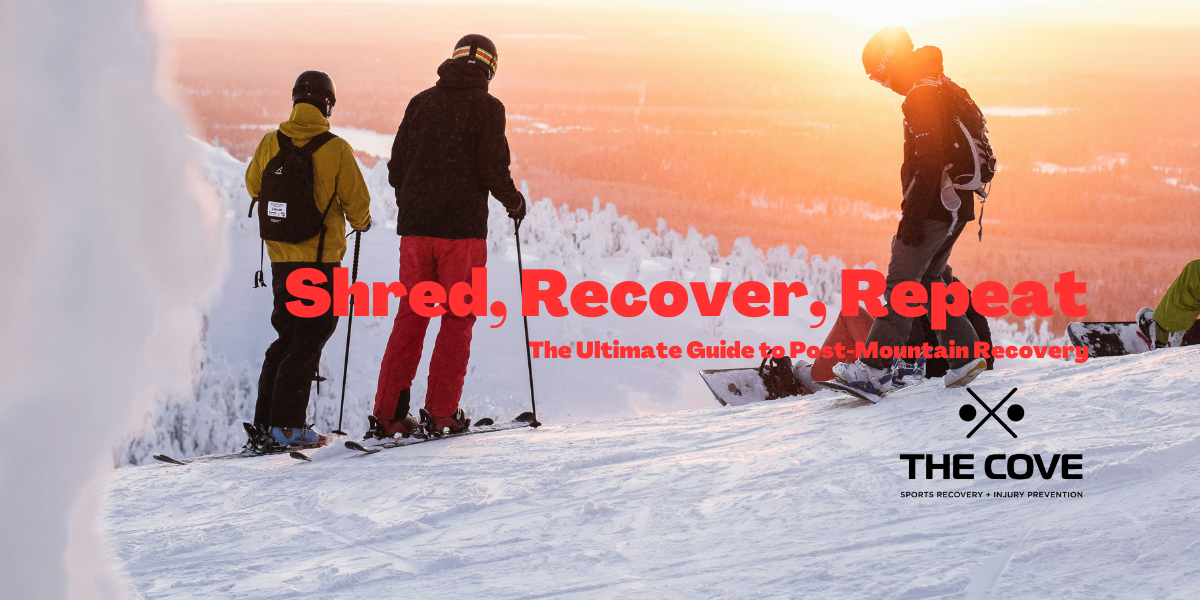Shred, Recover, Repeat: The Ultimate Guide to Post-Mountain Recovery
Nicholas FaddenAh, the mountains—the powder, the adrenaline, the occasional yard sale on a double black. Whether you’re carving down Whistler Blackcomb, hitting the jumps at Cypress, or tackling Grouse’s famous Cut, there’s nothing quite like a day shredding on the slopes. But what about the aftermath? The jelly legs, the sore back, and the realization that you might not bounce back like you used to?
That’s where the magic of recovery comes in.And as someone who once chased an Olympic dream in the decathlon (yes, all ten events, if you're wondering) and spent over a decade helping athletes and desk jockeys alike stay in top form, I’ve got your back—literally. Let’s dive into what you should and shouldn’t do after a day on the slopes to make the next day feel just as epic.
The Dos and Don’ts of Post-Ski Recovery
Do: Hydrate Like Your Life Depends on It
Between the altitude and the sweat you don’t notice in the cold, dehydration can sneak up on you. Proper hydration helps flush out metabolic waste (think lactic acid buildup) and keeps your muscles functioning optimally.
Pro Tip: Aim for electrolyte-rich drinks post-slopes. Water is great, but a little sodium, potassium, and magnesium can go a long way in speeding up recovery.
Don’t: Skip the Cool Down
Yes, après-ski beckons with its mulled wine and fondue, but skipping a proper cool down is the quickest way to regret life decisions the next day. A quick 5–10 minutes of light stretching or a slow walk around the village can do wonders for maintaining flexibility and easing muscle tension.
Do: Embrace the Power of Contrast Therapy
Here’s where things get sciencey. Research shows that contrast water therapy—alternating between hot and cold immersion—can improve circulation, reduce muscle soreness, and accelerate recovery (Wilcock et al., 2006).
At The Cove Sports Recovery, we’ve mastered the art of this with our perfectly calibrated hot (43°C) and cold (11–13°C) plunge tubs. On your way back from Whistler or any of the local mountains, pop by our West Vancouver location (Level 2, 1497 Marine Dr, just off Hwy 99). Whether you’re a weekend warrior or training for the next Winter Olympics, a quick session will leave you feeling ready to tackle another day on the slopes.
Don’t: Overindulge in Après-Ski Treats
Look, I’m not here to ruin your good time. But if your post-shred ritual involves nachos and three pitchers of beer, don’t be surprised when you wake up feeling sluggish. Recovery is about balance. By all means, enjoy yourself—but make sure to prioritize lean proteins and veggies alongside the indulgence. Your muscles will thank you.
Do: Use Compression Therapy
Nothing feels quite as magical as slipping into air compression pants after a day on the mountain. These bad boys work by improving circulation and reducing swelling, which is particularly helpful for those quads and calves that took a beating on the moguls. At The Cove, our NormaTec compression therapy is the perfect companion to your recovery routine.
Don’t: Forget About Sleep
If there’s one recovery tool we all underestimate, it’s sleep. Your body does its best repair work during deep sleep cycles. Lack of quality sleep not only hampers recovery but can also increase your risk of injury the next day.
Pro Tip: Aim for at least 7–9 hours of sleep and avoid screens for an hour before bed. Or better yet, book a recovery session at The Cove earlier in the evening—it’ll help you sleep like a log.
Why Recovery at The Cove Makes Sense
Skiing and snowboarding are demanding on your body. If you want to keep shredding without feeling like you’ve been hit by a snowcat, recovery is non-negotiable. The Cove is designed to make it easy and effective:
- Location, Location, Location: We’re just off Hwy 99 at the bottom of 15th Street, making us the perfect pit stop on your way back from Whistler Blackcomb, Cypress, Grouse, or Seymour.
- No Booking Stress: Walk-ins are always welcome, or you can book ahead to secure your spot.
- Tailored Recovery Services: From hot + cold plunges to air compression therapy, our options cater to every recovery need.
Why It Works
The science is clear: recovery isn’t just about avoiding soreness; it’s about improving performance, reducing injury risk, and extending the longevity of your favorite activities. Studies show that cold immersion reduces inflammation, while heat therapy improves muscle relaxation and circulation (Bleakley et al., 2012). Combine the two, and you’ve got a recipe for recovery that works on both a cellular and systemic level.
Final Thoughts
We all love a good day on the mountain, but the key to making every day as good as the last is a solid recovery routine. With just a little effort—and maybe a stop at The Cove—you can shred hard, recover smarter, and wake up ready to hit the slopes again.
So, whether you’re conquering Whistler’s Peak-to-Peak or chasing first tracks at Cypress, let us help you feel fresh, recharged, and ready. Your body—and your future self—will thank you.
References
- Wilcock, I. M., Cronin, J. B., & Hing, W. A. (2006). Physiological response to water immersion: A method for sport recovery? Sports Medicine, 36(9), 747–765.
- Bleakley, C. M., & Davison, G. W. (2012). What is the biochemical and physiological rationale for using cold-water immersion in sports recovery? British Journal of Sports Medicine, 44(3), 179–187.
🔗 Visit The Cove Sports Recovery
📍 Level 2, 1497 Marine Dr, West Vancouver
💻 Book Your Session Today
#RecoveryMadeEasy #ContrastTherapy #FeelFreshStayStrong #ShredRecoverRepeat #TheCoveSportsRecovery

